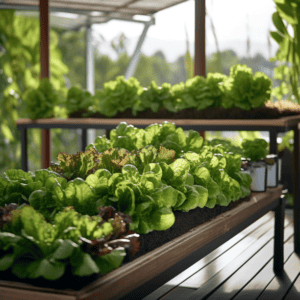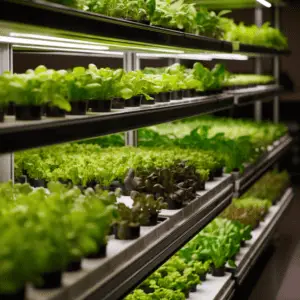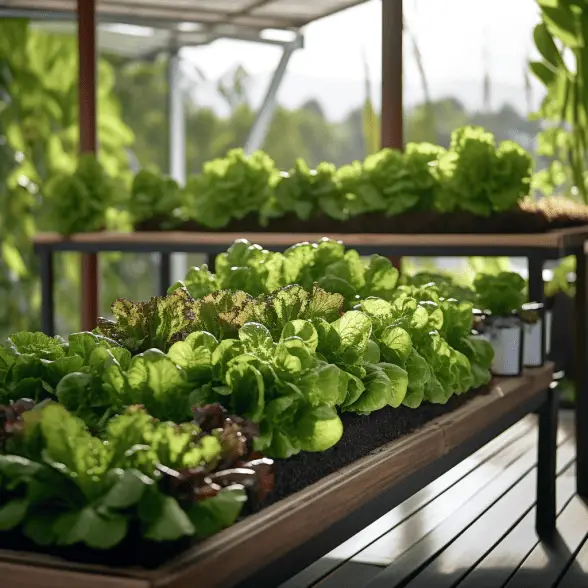
Are you tired of seeing pests invade your hydroponic garden? You’re not alone.
Pest management can be a challenging aspect of hydroponic gardening, but it’s essential to ensure the health and longevity of your plants.
With the right strategies and techniques, you can effectively address pests in your hydroponic garden.
One of the unique challenges of hydroponic gardening is that pests have easy access to plant roots, which are constantly immersed in nutrient-rich water.
This environment can attract a variety of insects, mites, and fungi that can damage or kill plants if left unchecked.
However, with proper prevention and control methods, you can keep these pests at bay and maintain a healthy crop yield.
In this article, we’ll cover various pest control strategies for hydroponic gardens so that you can keep your plants thriving all year round.
KEY TAKEAWAY
How to address pests in your hydroponic garden?
To address pests in your hydroponic garden, it is important to implement a comprehensive pest management plan that includes preventive measures.
The measures involve maintaining proper hygiene and using natural pest control methods like neem oil and beneficial insects.
It is also important to regularly inspect your plants to catch any pest infestations early on and take immediate action to prevent further spread.
By following these steps, you can maintain a healthy and thriving hydroponic garden while minimizing the use of harmful pesticides.
Understanding the Unique Pest Challenges of Hydroponic Gardening

Growing plants in a hydroponic system creates a unique environment that can attract unwanted creepy-crawlies, making it crucial to understand the specific challenges of pest control in this style of gardening. (1)
One major challenge is the lack of soil as a natural barrier against pests.
This means that pests such as spider mites and aphids can easily spread from plant to plant without any natural obstacles.
Another challenge is the high humidity levels that are typical in hydroponic systems.
While high humidity is great for plant growth, it can create an ideal breeding ground for certain pests, such as fungus gnats.
These tiny insects lay their eggs in moist growing media, and their larvae thrive in damp conditions.
Lastly, because hydroponic gardening typically involves growing plants indoors or under cover, there may be limited access to natural predators that would otherwise keep pests at bay.
For example, ladybugs are known to consume aphids but may not be present if you’re growing your crops indoors.
With these unique challenges in mind, it’s important to take preventive measures when setting up your hydroponic garden.
By building a strong foundation for pest control from the beginning, you’ll be able to minimize the risk of developing pest problems down the line.
Prevention: Building a Strong Foundation for Pest Control

Source: GRANDEUR AFRICA
To keep unwanted critters at bay, you’ll want to make sure your hydroponic setup is clean and organized from the get-go.
This means regularly checking for any debris or dead plant matter that may have accumulated in your system, as these can attract pests. (2)
Additionally, make sure to properly dispose of any plant trimmings or waste outside of your growing area to prevent them from becoming a breeding ground for insects.
Another important aspect of prevention is maintaining proper temperature and humidity levels in your hydroponic garden.
Pests thrive in warm and humid environments, so keeping your grow room cool and dry can help deter them from taking up residence.
Additionally, be sure to monitor the pH level of your nutrient solution regularly, as imbalances can weaken plants and make them more susceptible to infestation.
Lastly, it’s crucial to implement good hygiene practices when working with your plants.
Always wash your hands before handling anything in the grow room, and consider wearing gloves or using sanitizing solutions on tools and equipment between uses.
By taking these preventive measures seriously, you’ll establish a foundation for successful pest control in your hydroponic garden.
Now that you’ve built a strong foundation for pest control through prevention methods like cleanliness and environmental monitoring, let’s take a look at cultural control measures you can use to further protect against pests in your hydroponic setup.
Cultural Control Measures for Hydroponic Pest Management
Cultural control measures, such as crop rotation and companion planting, can effectively manage pest populations in hydroponic systems while promoting overall plant health and yield.
Did you know that, according to a study by the University of California, Davis, using beneficial insects for biological control resulted in a 52% reduction in pest populations compared to chemical treatments?
Here are some cultural control measures you can implement in your hydroponic garden:
- Rotate crops: This involves switching out crops with different ones after each harvest cycle.
This helps reduce the likelihood of pests becoming established because they don’t have a consistent food source.
- Choose plants that are not related to each other: Pests tend to target specific plant families or groups.
By rotating crops with non-related plants, you will disrupt their life cycle and reduce their population growth.
- Companion planting: Certain plants emit strong odors that repel pests or attract beneficial insects.
Planting these alongside your main crop creates a natural barrier against pests.
Examples of companion plants include marigolds (repels aphids), basil (repels whiteflies), and mint (attracts predatory wasps).
By implementing these cultural control measures into your hydroponic garden, you can effectively manage pest populations without resorting to harmful chemicals.
These methods also promote overall plant health and increase yields.
In the next section, we’ll discuss biological control strategies for hydroponic pests – let’s dive in!
Biological Control Strategies for Hydroponic Pests
Now let’s talk about how you can naturally combat pesky insects in your hydroponic setup using biological control strategies.
One effective method is introducing beneficial insects like ladybugs, lacewings, and predatory mites into your garden.
These predators will feed on the harmful pests without causing any harm to your plants.
You can purchase these beneficial insects from online retailers or local nurseries.
Another biological control strategy is using nematodes, which are microscopic worms that prey on soil-dwelling pests like fungus gnats and root aphids.
These nematodes can be applied as a liquid solution to the growing medium in your hydroponic system.
They work by infecting the pest with bacteria that eventually kills them.
Lastly, incorporating organic plant extracts and oils like neem oil and garlic extract into your hydroponic nutrient solution can also help deter pests.
These natural remedies are safe for both your plants and beneficial insects while effectively repelling unwanted pests.
Incorporating biological control strategies into your hydroponic setup not only helps reduce pesticide use but also promotes a healthier ecosystem for both plants and beneficial insects.
However, if these methods prove ineffective against persistent infestations, it may be necessary to explore chemical control options for hydroponic pest management, which we’ll discuss in the next section.
Chemical Control Options for Hydroponic Pest Management
The use of chemical control options for managing pests in hydroponic systems is a common practice, with over 70% of commercial hydroponic growers using some form of insecticide or fungicide.
While it may not be the most environmentally friendly option, it can be effective when used correctly.
Here are some things to keep in mind when considering chemical control options:
- Choose the right product: Different chemicals work better on different pests, so make sure you know exactly what you’re dealing with before choosing a pesticide.
- Read the label carefully: Pesticides can be harmful to both humans and plants if not applied properly.
Make sure to follow all instructions on the label and take necessary precautions such as wearing protective gear.
- Use sparingly: Overuse of pesticides can lead to resistant pest populations and harm beneficial insects.
Only apply when absolutely necessary and at recommended rates.
It’s also important to note that some chemicals may not be suitable for use in hydroponic systems due to potential toxicity or damage to equipment.
Always do your research before applying any chemical control measures in your hydroponic garden.
Integrated Pest Management: Combining Strategies for Best Results
By combining different pest management strategies, you can create an integrated approach that maximizes effectiveness while minimizing negative impacts on the environment.
Integrated Pest Management (IPM) is a holistic method that incorporates cultural, physical, and biological control tactics to manage pests in hydroponic gardens.
Instead of relying solely on chemical pesticides, IPM offers a more sustainable solution that promotes long-term plant health.
Cultural practices are an essential component of IPM.
These include maintaining proper sanitation by removing dead plant material and debris regularly, keeping the grow area clean, and avoiding overcrowding plants.
Physical controls involve physically removing pests or using barriers to prevent them from entering the garden.
For example, placing sticky traps around the grow area can help trap flying insects like whiteflies and thrips.
Biological controls use natural enemies to target specific pests without harming other beneficial organisms in the garden.
Some examples include releasing ladybugs or lacewings to eat aphids or using nematodes to control root-dwelling pests like root-knot nematodes.
By combining these three strategies – cultural practices, physical controls, and biological controls – you can create an effective integrated pest management plan for your hydroponic garden that minimizes chemical pesticide use while reducing pest populations.
As you implement IPM in your hydroponic garden, it’s important to continually monitor for signs of pest activity.
Early detection is key to controlling infestations before they become severe.
In the next section, we’ll discuss how to identify common pests found in hydroponic gardens so that you can quickly respond with appropriate control measures if needed.
Monitoring and Early Detection of Hydroponic Pests
You don’t want to be caught off guard by pesky invaders, so keep a close eye on your plants and stay vigilant for any signs of trouble.
Regular monitoring is essential to catch problems early before they become major infestations.
Check your plants daily for any changes in color, texture, or growth patterns that could indicate the presence of pests.
When monitoring your hydroponic garden, pay special attention to the undersides of leaves where many pests like to hide.
Look for tiny eggs, webs, or sticky residue left behind by insects.
Use a magnifying glass if necessary to get a closer look at any suspicious spots or specks on your plants.
By identifying potential issues early on, you can take action quickly and prevent further damage.
If you do spot signs of trouble in your hydroponic garden despite your best efforts at prevention and monitoring, don’t worry – there are still steps you can take to address the problem.
In the next section, we will cover common hydroponic pest problems and offer tips for troubleshooting them effectively.
Remember that with patience and persistence, you can overcome any challenge that comes up in your gardening journey!
Troubleshooting Common Hydroponic Pest Problems
If you’re struggling with unwanted visitors in your hydroponic setup, don’t fret – we’ve got tips to help you nip those pesky pests in the bud.
One of the most common problems is spider mites, which can quickly infest and damage your plants.
To address this problem, start by removing any affected leaves or branches and then use a neem oil spray or insecticidal soap to kill off any remaining mites.
Diligent monitoring and regular application will be key to keeping them at bay.
Another common issue is aphids, which may appear as small green or black insects on your plant’s leaves.
These pests can reproduce rapidly so it’s important to act fast.
Start by manually removing as many aphids as possible and then apply a solution made from water and dish soap to suffocate any remaining bugs.
Repeat every few days until they’re gone for good.
Finally, fungus gnats are another nuisance that commonly affects hydroponic gardens.
These tiny flies lay their eggs in damp soil or growing media which hatch into larvae that feed on plant roots.
To get rid of them, let the top layer of growing media dry out completely between watering sessions.
You can also use sticky traps or beneficial nematodes to kill off larvae before they have a chance to mature into adult gnats and continue the cycle again.
With these tips, you’ll be able to tackle pest problems head-on and keep your hydroponic garden thriving!
Conclusion
Congratulations! You’ve successfully tackled the pest challenges in your hydroponic garden.
By understanding the unique characteristics and vulnerabilities of hydroponic gardening, you were able to build a strong foundation for pest control.
Through cultural, biological, and chemical control measures, as well as integrated pest management strategies, you effectively prevented and managed any unwanted guests.
As you stand back and admire your thriving hydroponic garden, with lush green leaves and vibrant fruits and vegetables bursting forth, take a moment to appreciate the hard work that went into keeping it healthy and thriving.
You’re now an experienced hydroponic gardener who has mastered the art of pest management.
So go ahead – pat yourself on the back, sit back with a glass of homemade lemonade from your own lemon tree, and enjoy the fruits of your labor!
If you have other problems regarding hydroponics, you can refer to the article here.
References
- https://www.edengreen.com/blog-collection/types-of-hydroponics-pests
- https://www.saferbrand.com/articles/how-control-hydroponic-pests
Related Articles
- https://tophydroponicgarden.com/hydroponic-mistakes-troubleshooting/
- https://tophydroponicgarden.com/common-hydroponic-mistakes/
Was this helpful?

Crystal Erickson is an agriculture enthusiast and writer with a passion for sustainable farming practices and community development. Growing up on a family farm in rural Iowa, Crystal developed a love for the land and a deep appreciation for the hard work and dedication required to make a farm successful.
After completing a degree in Agriculture and Environmental Science from Iowa State University, Crystal began her career as an agricultural journalist, covering stories and issues related to modern farming practices, crop management, and livestock production. She quickly established herself as a respected voice in the industry, known for her insightful reporting and thoughtful analysis.
Over the years, Crystal has written for a variety of publications, including Farm Journal, Successful Farming, and Modern Farmer, as well as contributing to several academic journals focused on sustainable agriculture and community development. Her work has been recognized with numerous awards, including the Iowa Farm Bureau’s Young Farmer Achievement Award and the National Association of Farm Broadcasting’s Farm Broadcaster of the Year.

